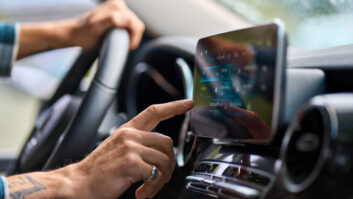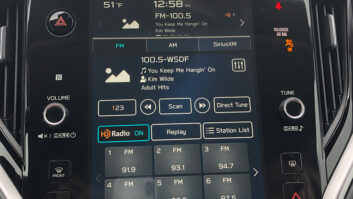The author is chairman of the DRM Consortium. Her commentaries appear regularly at radioworld.com.
A tradition is being born in India. The India Automotive Infotainment Forum, a yearly event co-hosted by the DRM Consortium and one of its key members NXP, explores the latest trends and innovations for radio and audio in the car.
DRM speakers focused on the great progress made by the Indian automotive industry in the past five years, with more than 5 million cars with DRM receivers. The presentations concluded with practical demonstrations of DRM for FM in cars, rounding up a lively and successful event on Sept. 28.
First, the participants got a summary of the latest global infotainment market trends. The notion that “radio is dead” was repudiated with facts and figures. In a recent press article, Udit Tyagi, chief digital officer for Indian media giant Mirchi, said, “Audio is now attractive, and digital attention is moving in that direction,” adding that “the phase for audio has come.”
Radio is resilient and the peak times for radio listening remain unchallenged. Breakfast is a radio station’s peak time in most countries. People tune in to get their local news, traffic and weather and to hear about what matters to them in their city or region. There are over 120 million automotive tuners in cars to date, and big manufacturers like Skyworks or NXP offer tuners now that cover both the analog and the main digital standards.
In the United States, radio reaches 87% of the population. In a typical day, most people in the United States listen to AM/FM radio while relatively few listen to Pandora, Spotify or SiriusXM (satellite radio), and more than 90% only listen to AM/FM radio, according to the “Share of Ear” study in the US (“Share of Ear” Q2 2022).
This also highlights that AM/FM radio has a stunning 89% share of ad-supported audio in U.S cars. This has remained the case for the last six years, despite COVID-19, and the much-debated subject of interference in new electric vehicles (EVs), and the chipset crisis.
Similarly, radio listeners in the United Kingdom are tuning into more than 20 hours a week with live radio, reaching 88% of the population in the second quarter of 2022, according to audience research organization RAJAR. A lot of the listening is done in cars.
[Read More Guest Commentaries Here]
As mentioned, in the last five years in India the number of cars with line-fitted digital DRM radios has increased dramatically, reaching about a third of all new cars or over 5 million vehicles. These receivers have no electricity supply issue, are supported by advanced digital-analog chipsets and are the cheapest receivers available. In fact, the cost of DRM/analog receivers in certain Indian car models is included in the price of the vehicle, at no cost to the buyer.
The beauty of these receivers is that they are hybrid analog/digital. The upgrade of a medium-wave DRM receiver to DRM in FM can also be done via software and after-sales upgrades are also available.
The receiver or rather the chipset also supports digital multi-standard solutions. This can be useful in places like South Africa which has adopted both DRM and DAB+ as official digitization standards.
Automotive Infotainment Solutions
However, the automotive eco-system must already react to a complex future which includes electric and self-driving vehicles, a great thirst for things video even in the car, for a rich and complex audio and text offer, for interactivity.
The global automotive industry must think holistically and deliver the full digital cockpit as 90% of drivers and people generally seem to still want a radio tuner in their car for free, live news and music. This translates into an exponential requirement (some say a threefold increase) in electric components needed for the car to deliver the “hybrid” entertainment system including analog, digital and IP radio. The driver of the future will want to be always connected, get fresh updates continuously and have a wealth of features at the tip of their fingers (whilst driving safely!).
The forum also focused on some general challenges. The participants heard a lot about radio reception in EVs, especially those with AM reception.
Electrical hybrid cars suffer from wideband noise which cannot be completely solved just by adding expensive shielding and filtering. The good news is that there are now practical solutions being tested and shown that turn distorted AM signals into an enjoyable AM reception, all without need for extra hardware. There is a particular case to be made for shortwave, and it is quite clear that DRM shortwave, unlike analog, provides a higher level of defense in cars against “electrical noise.” One advantage of DRM is also that it delivers emergency warning functionality, increasingly demanded all over the world.
Of particular interest for the Indian market is also the extension of the DRM standard to FM. A governmental decision on this is still awaited after the successful and complex demonstrations of DRM in FM done in New Delhi and Jaipur a year ago. Several radio receivers, including those fitted in cars were used for these demonstrations in India.
Similar car head units were also used for the recent DRM AM and FM tests done in Australia.
At the Infotainment India Forum several companies made presentations on their receiver work for the automotive industry. Of particular interest was the presentation of chipset solutions that often require just a software upgrade to satisfy different standard demands across the globe. But there are already millions of cars on the road without a digital receiver.
The GR-250, a new after-market stereo car receiver from Gospell for analog and DRM AM and FM, was examined with great interest.

Also in the Gospell pipeline is a new DRM USB dongle that works with most Android car stereos, using existing car antennas and controlled by app.

Conclusion
Innovatively, the 3rd India Infotainment forum included live demonstrations on NXP solutions for the DRM in FM band and for improved robustness towards an uninterrupted radio experience in electric and hybrid cars, in the FM but also in the AM bands.
The conclusion of the forum was that the Indian automotive industry has clearly embraced DRM digital radio, though the work must be sustained in the future.
The question to the participants was how best to act in order to support a quick governmental decision in favor of extending DRM radio services adopted in India already for the AM bands to the FM band. This can only be a collective and multi-strand effort.
A parallel way forward is also to get a governmental decision to mandate digital DRM radios in cars, as it was done in the EU space. A strong case was also made for developing DRM solutions in AM, still required in the Indian cars. This presupposes improved content, publicity by broadcasters for DRM, i.e., making DRM and its benefits known through advertising and extensive marketing and PR.
The ultimate message is that the automotive industry in India is thriving, and DRM can enhance the performance of the many existing and new cars which millions of Indians desire and will own in numbers.







